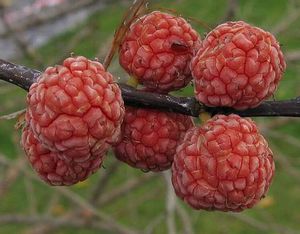

Pinyin: Zhe Latin: Cudrania Tricuspidata
Physical Characteristics
Cudrania Tricuspidata is a decidious Tree growing to 6m by 6m at a slow rate, is hardy to zone 7, is in flower in July. The flowers are dioecious (individual flowers are either male or female, but only one sex is to be found on any one plant so both male and female plants must be grown if seed is required). The plant is not self-fertile. The plant prefers light (sandy) and medium (loamy) soils and requires well-drained soil, prefers acid, neutral and basic (alkaline) soils, cannot grow in the shade, and requires moist soil.
Family
Edible Uses*
Edible Parts: Fruit; Leaves.
Cudrania Tricuspidata Fruit - fresh or preserved[1, 22, 61]. Somewhat like a mulberry[183]. The firm fruit is relatively tasteless, when soft-ripe it is sub-acid to sweet and some forms can be quite delicious[46, 105, 109, 151, 183]. Cudrania contains lots of large seeds[151]. The Cudrania fruit is about 25mm in diameter[200]. Cudrania Tricuspidata Leaves a famine food[179].
Traditional Chinese Medicinal (TCM) Uses:*
Cudrania Tricuspidata is Antiperiodic; Galactogogue; Ophthalmic; use in Women's complaints. An infusion of the wood is used to treat sore or weak eyes[178, 218].*
Cudrania Tricuspidata's inner bark and the wood are used in the treatment of malaria, debility and menorrhagia[178, 218]. The root is galactogogue and is also used in the treatment of amenorrhoea[218]. The plant is used to eliminate blood stasis and stimulate the circulation in cancer of the alimentary system, blood and lungs[218].*
References
- [1] F. Chittendon.RHS Dictionary of Plants plus Supplement. 1956 Oxford University Press 1951
- [22] Sholto-Douglas. J.Alternative Foods. 0
- [46] Uphof. J. C. Th.Dictionary of Economic Plants. Weinheim 1959
- [61] Usher. G.A Dictionary of Plants Used by Man. Constable 1974 ISBN 0094579202
- [105] Tanaka. T.Tanaka's Cyclopaedia of Edible Plants of the World. Keigaku Publishing 1976
- [109] Wilson. E. H.Plantae Wilsonae. 0
- [151] Wilson. E. H. and Trollope. M. N.Corean Flora. Royal Asiatic Society 1918
- [178] Stuart. Rev. G. A.Chinese Materia Medica. Taipei. Southern Materials Centre 0
- [179] Reid. B. E.Famine Foods of the Chiu-Huang Pen-ts'ao. Taipei. Southern Materials Centre 1977
- [183] Facciola. S.Cornucopia - A Source Book of Edible Plants. Kampong Publications 1990 ISBN 0-9628087-0-9
- [188] Brickell. C.The RHS Gardener's Encyclopedia of Plants and Flowers Dorling Kindersley Publishers Ltd. 1990 ISBN 0-86318-386-7
- [200] Huxley. A.The New RHS Dictionary of Gardening. 1992. MacMillan Press 1992 ISBN 0-333-47494-5
- [218] Duke. J. A. and Ayensu. E. S.Medicinal Plants of China Reference Publications, Inc. 1985 ISBN 0-917256-20-4
Source: Cudrania Tricuspidata Plants For A Future, England 1996-2008.
This work is licensed under a Creative Commons License.
Natural dietary supplements are designed to offer the body support to promote health, harmony, balance and overall well being.*

 Get Well Natural, LLC
Get Well Natural, LLC  Kidney Function & Regeneration Health
Kidney Function & Regeneration Health  Platelet & Blood Cell Health
Platelet & Blood Cell Health  Prostate, Flow & Function Health
Prostate, Flow & Function Health  General Mind & Body Health
General Mind & Body Health  Heart, Cholesterol & Cardio Health
Heart, Cholesterol & Cardio Health  Allergy-Free Body
Allergy-Free Body  Anxiety & Stress
Anxiety & Stress  Blood Platelet Counts & Function
Blood Platelet Counts & Function  Blood Pressure Health
Blood Pressure Health  Kidney Function Health
Kidney Function Health  Immune System Health & Balance
Immune System Health & Balance  Prostate & Urinary Health Function
Prostate & Urinary Health Function  Blood Sugar Balance
Blood Sugar Balance  Cardiovascular Heart Health
Cardiovascular Heart Health  Detoxification & Healthy Cells
Detoxification & Healthy Cells  Women's Health
Women's Health  Liver Regeneration
Liver Regeneration  Pain-Free Body
Pain-Free Body  Water & Air Filtration
Water & Air Filtration 


